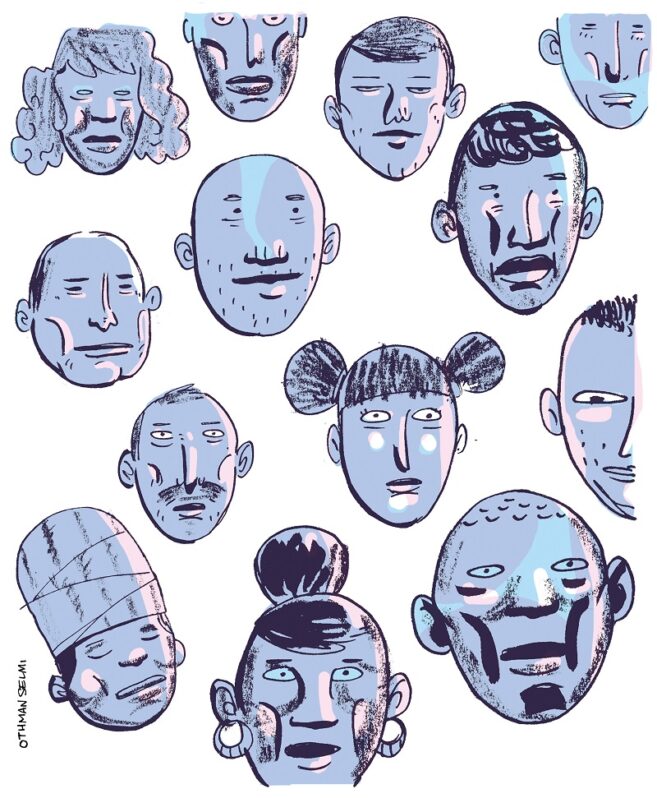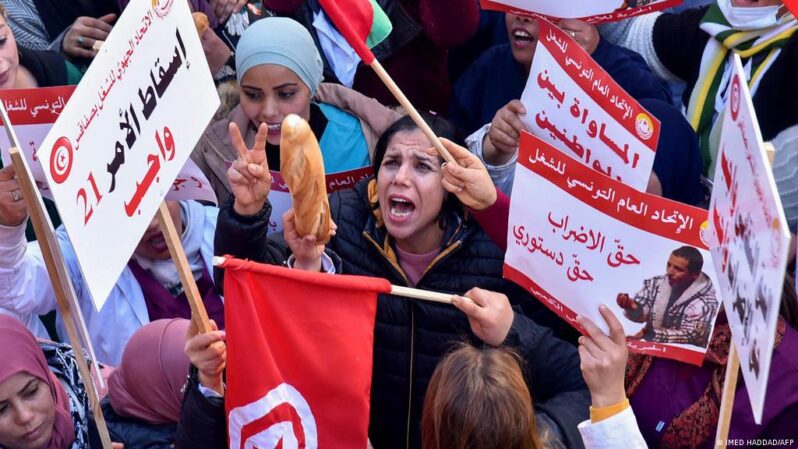The Judicial Dimension of Transitional Justice in Tunisia: A Critical Analysis

At the end of July 2018, Tunisia’s Truth and Dignity Commission (TDC) referred 19 cases to the specialized judicial chambers for transitional justice. All these cases are expected to be examined during the 2018-2019 judicial year. The number is expected to grow because of the pressure the TDC is facing from the victims of violations, who have accused it of underperforming, and have organized protests demanding to know what it has done with their cases.[1] It is important to examine the characteristics of these cases, the violations they concern, and the means whereby they were selected as they will, because of the trials, occupy an important place in the Tunisian memory of the Republic’s first decades.
In its internal documents, the TDC specified five criteria for determining the complaints it would refer to the judiciary. First, they should involve prosecuting even the highest officials in the chain of command. Second, they should represent the various affiliations and geographic regions (there are 13 specialized chambers). Third, they should represent the different historical eras. Fourth, they should include evidence. Fifth, they should represent the various violations. The sample of cases thus far referred to the chambers suggests that these criteria were not followed. Here is why:
1. The Number of Victims
Only eight of the 19 cases include more than one victim. The total number of victims in the cases is 225. This number of victims and cases is tiny in comparison to the number of complaints the TDC received, namely 62,713.[2] All the cases selected were classified grave violations of human rights.
2. The Violations
The violations that the cases concern ranged from intentional homicide via shooting with live bullets to homicide, which was often preceded by torture, rape, or forced disappearance. On the other hand, the indictments contained no charges of financial corruption, execution without fair trial guarantees, election fraud, or forced emigration.
This approach seems to conflict with the statements of the TDC, which, amid its struggle with the government, repeatedly advocated holding those accused of financial corruption accountable, rejecting any talk of reconciliation with them. It also conflicts with the insistence of the majority in the National Constituent Assembly that the trials born from the transitional justice process encompass election fraud and forced emigration.
Hopefully, the TDC will, in the future, take the initiative to submit cases pertaining to these classes of violations to the specialized chambers out of respect for the legislators’ will and to dispel the suspicions about a conflict of interests that has come to surround its management of the reconciliation and arbitration issue.
3. The Victim’s Gender in the Cases of Individual Violations
The TDC allocated one of its committees to “women victims”. The president of this committee, Ibtihal Abdellatif, justified this choice on the basis of “the peculiarity of the situation of women victims, firstly, and ensuring their involvement in the transitional justice process, secondly”. While Abdellatif pledged that her committee would “work to ensure the TDC is committed to applying a gender approach in applying the Transitional Justice Law”,[3] only in one of the 11 cases involving a single victim was that victim female. Making matters worse, the TDC received “16,000 cases of female victims, not taking into account the cases of women who were indirect victims”.[4] Hence, it is hoped and expected that the TDC will rectify this shortcoming such that its performance matches its discourse.
4. The Era and Occasion that the Cases Concern
From this angle, the cases that the judiciary will examine are divided as follows:
-
Two cases pertaining to the Bourguiba era, specifically events that occurred in its final two years.[5]
-
Seventeen cases pertaining to the Ben Ali era, divided as follows:
-
Eleven cases of violations in the 1990s during the Ben Ali regime’s persecution of Islamists.
-
One case pertaining to the Gafsa Mining Basin uprising in 2008, which a number of historians consider one of the first signs of the social movement that ended in the Tunisian revolution.
-
Five cases pertaining to the Tunisian revolution.
Note that the Transitional Justice Law specified that it applies to the period from the beginning of July 1955 to the end of 2013. This choice, which was put forward in the National Constituent Assembly while the law was being discussed, was justified on the basis that this period witnessed many crimes against humanity that went without accountability, which led to a culture of impunity. Hence, the fact that most of the cases selected are limited to a time period spanning no more than one decade seems to contradict the philosophy of the Tunisian legislation and the desire to reverse the culture of impunity.
5. The Political Affiliation of the Victim or the Movement that Prompted the Abuse
From this angle, the cases referred are distributed as follows:
-
Six cases pertaining to social protest movements in whose occurrence the victims’ political affiliation played no role. Five pertain to events of the revolution,[6] whereas the sixth pertains to the Mining Basin uprising (2008).
-
Twelve cases pertaining to the political regime’s persecution of Islamist activists. While two cases related to members of the Islamic Tendency Movement [now called the Ennahda Movement Party] in 1986 and 1987, nine cases related to the persecution of activists and members of the same political community in 1991. To these cases can be added a case pertaining to a student movement revolving around the confrontations between the security forces and students that broke out on the university campus in Tunis on 8 May 1991. These events occurred against the backdrop of a decision that the ministers of interior and higher education issued on 29 March 1991, to suspend the activity of the Tunisian General Student Union, a student organization affiliated with the Islamic Tendency Movement, on the grounds that it had deviated from the goals set for it and violated the Associations Law.
-
One case pertaining to the “Barakat al-Sahil affair”. The victims are former military personnel who were charged by the Ben Ali regime with attempting a coup. The same regime later admitted, after persecuting and making examples of them, that the charge was false.
-
A case pertaining to leftist activist Nabil Barakati, who was one of the founders and historical symbols of the Tunisian Workers’ Communist Party. Barakati was tortured to death in the National Security station in Gaafour after his arrest on 28 April 1987.
This cases survey reveals two things. The first is the significant presence of cases of the revolution’s casualties in the accountability process, and the second is the dominance of victims belonging to and affiliated with Ennahda over that process. Giving prominence to these two types of victims seems to be justified by the following two points:
-
Organic Law no. 17 of 2014, which supplements the Transitional Justice Law,[7] expressed a legislative will to retry the cases of casualties of the revolution before the specialized chambers because of dissatisfaction with what were at the time considered lenient sentences handed down by the military courts in those cases. The TDC appears to have committed to referring the cases of the revolution’s martyrs in the spirit of this legislation.
-
The survey that the TDC conducted and whose results it announced in mid-October 2016 showed that 32,228 direct victims of the persecution of Islamists during the authoritarian era had submitted complaints to the TDC. On the other hand, the total number of victims of violations in the persecution of the left was just 3,308.[8] Hence, it is logical for the number of Islamist victims’ cases to be the highest, even if the TDC’s work methodology in the public hearings suggested it might adopt samples from all the political communities in a manner that strikes a balance between the reality of a numerical majority and the reality of the diversity in the periods of persecution and the victims’ political backgrounds.
6. The Geographical Distribution of the Cases
The specialized chamber in Tunis was given the largest share of the cases (9 of 19), followed by the Nabeul chamber with 3 cases, then the Sidi Bouzid chamber with two cases. The five remaining cases were divided among the other five chambers. As the number of cases grows, it is expected that the discrepancy between the chamber in the capital and the other chambers will deepen.
The chambers’ first hearings, which were held at the end of the 2017-2018 judicial year, revealed the negative effect limited material resources have on the logistics of historical trials such as these. The first hearing to examine the case of victim Mawlidi bin Umar, held on 5 July 2018, in the Palace of Justice in Tunis, was adjourned because the necessary operating conditions were absent. If legislative reform of the specialized chambers is considered, it may be important to establish a single specialized chamber that has all the [necessary] human and material resources and whose rulings are appealable.
Observations from the Courtrooms
1. During initial hearings before the 2017-2018 judicial year ended, the specialized chambers examined eight of the cases they had received, whereas hearings for the remaining cases were scheduled for after the judicial holiday.
2. A number of victims and representatives of their associations accompanied the TDC’s members to the courthouses hosting specialized chambers to be present when their cases were submitted to the Public Prosecution. A number of them also erected tents and organized demonstrations in front of the courthouses that held their first hearings. In this regard, although the victims’ participation in the course of the trials is one of the prerequisites for their success, this must not lead the defendants to feel that their trials are retaliatory or lack fair trial conditions.
3. International donor organizations pledged to equip the courtrooms with speakers and witness boxes. In the hearing to examine Mawlidi bin Umar’s case broadcast on 5 July 2018, their failure to fulfill their commitment led to disorder among the attendees, who protested the poor organization. This raises the question, will these organizations continue this effort throughout the examination of these cases, or will the volume of cases overwhelm them and prevent them from doing so?
4. The resignation of four judges assigned to the TDC for investigative work, which left a single retired judge working in this function as supervisor over the Investigation Unit, greatly disrupted its investigative work. Consequently, the investigative aspects of its indictments were mainly copied from the investigations conducted by the judicial and military judges in the same crimes.
5. The TDC explained some of its indictments by stating that the lenient sentences do not respect the victim’s right to a fair trial, which allows it to request a retrial. This explanation raises the question, are the specialized chambers being asked to issue fair rulings or to implement a vision of justice that requires increasing the sentences of people who have already been punished for the same actions?
6. The first hearings the chambers held witnessed a modest presence of those accused of violations.
7. One of the accused in the Nabil Barakati case, which was examined by the El Kef chamber, stated that he was previously tried for the same act, that during that first trial he was prevented from appointing a lawyer and was sentenced to corporal punishment, and that he now refuses to appoint a lawyer because he feels wronged. His anger and sense of injustice clearly embarrassed the court, which insisted on postponing the case so that he can appoint a lawyer.
8. The trial hearing pertaining to Faisal Barakat’s case was attended by two of the accused, namely a former judge and a member of the security forces. The latter maintained that he committed no grave violation against the victim and that the referral by the TDC included him by mistake. Fortunately, the victim’s brother, Jamal Barakat, attended the hearing and confirmed that he did not know the man who appeared before him, that this man was not the person concerned, and that the issue was merely one of similar names. Remarkably, he stated that he clarified this matter to the TDC’s investigation unit, but it nevertheless referred the wrong person.
9. When the case of victim Othman Ben Mahmoud was examined, the president of the hearing ordered the attendees not to photograph the judges to protect them and provide them with guarantees. His decision was not implemented, and that same day recordings of the hearing and photos of the court bench were circulated on social media.
This article is an edited translation from Arabic.
[1] The “What Happened in my Case?” [Milaffi Ash Sar Fi] campaign.
[2] As counted by the TDC. Note that in defining a victim, the TDC employs the concepts of “direct victim” – i.e. the person on whom the violation was inflicted – and “indirect victim” – i.e. someone who was morally or materially harmed by the violation in a collateral manner. Hence, a violation inflicted on a single individual could account for multiple victims. We cannot abandon this classification here because only the TDC possesses the statistics concerning the direct victims and it has not made them public.
[3] “Lajnat al-Mar’a bi-l-Hay’a Tasta’rid Muqarabataha fi Yawm ‘Ilmi Hawl ‘al-‘Adala al-Intiqaliyya wa-l-Naw’ al-Ijtima’iyy”, published on the TDC’s website, 10 February 2017.
[4] Ibtihal Abdellatif’s intervention in the activities of the “Academic Day on ‘Transitional Justice and Gender’”, which was held in the Faculty of Legal, Political, and Social Sciences of Tunis on 10 February 2017, under the supervision of the International Center for Transitional Justice. Its summary was published on the TDC’s website.
[5] The case of Nabil Barakati, who was tortured to death on 9 May 1987, and the case of Uthman Shuaybi, 1986.
[6] The events of the revolution in Thala and Kasserine; the events of the revolution in Bouzaiane; the events of the revolution in Regueb; the events of the revolution in Rue De Cologne; the events of the revolution in el-Kram el-Gharbi.
[7] Organic Law no. 17 of 2014, dated 12 June 2014, on Provisions Concerning Transitional Justice and Cases Connected to the Period from 17 December 2012, to 28 February 2011.
[8] Majdi al-Warfali, “TDC: 32 Alf Dahiyya Khilal al-Sidam ma’ al-Islamiyyin wa-3308 Khilal Mulahaqat al-Yasariyyin”, 14 October 2016.



